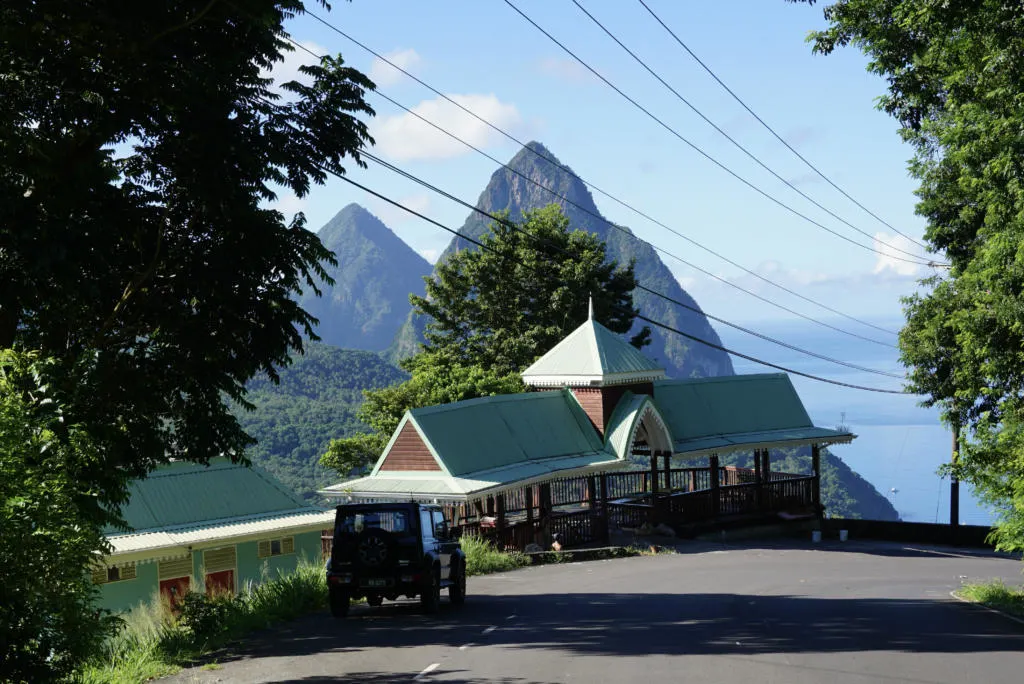
Wondering how to get around St. Lucia for an upcoming trip to this incredible Caribbean island? This guide covers all the best modes of transportation for getting around the island and some guidance on choosing which is best for you. Whether from airport to hotel, Airbnb to restaurants, resort to beaches, there are plenty of suitable options for getting around St. Lucia.
But first, a quick little summary of the island to help familiarize yourself with St. Lucia.
The North – The most touristy and densely populated area in St. Lucia with the capital city of Castries, and nearby Rodney Bay and Gros-Islet. Lots of resorts, hotels, beaches, restuarants, markets, etc.
The South – Vieux-Fort is the biggest southern city, where the major Hewanorra International Airport is located. Most visitors will begin by flying here. Still some resorts and touristy things.
The West – The famous twin Piton mountains (a UNESCO World Heritage Site) are located on the west coast near the town of Soufriere. Home to many fancy and exclusive resorts, and also some more modest accommodations. Also a popular touristy hub for the most popular hiking, waterfalls, mudbaths, hot springs, etc. on the island.
The East – Faces the rougher wind and waves from the Atlantic ocean, sparsely populated, less mountainous, less touristy. Dennery, a fishing village, is the biggest town.
There are two airports in St. Lucia, Hewanorra International Airport (UVF) and the much smaller George F. L. Charles Airport (SLU). Most visitors will arrive via airplane to the larger airport, UVF in Vieux-Fort at the southern tip of the island. So, most vacations to St. Lucia will begin with a shuttle or taxi ride from UVF airport to your destination. Some hotels and resorts may offer a shuttle from the airport to the hotel, so be sure to check on that. Otherwise, you are most likely to be picking up a rental car or taxi right from the airport.
The smaller SLU airport in the northern capital city of Castries offers mostly short flights between Caribbean islands. Or some visitors may come by cruise ship or ferry, docking in Point Seraphine in Castries.
This post may contain affiliate links. Disclosure policy.
Taxis in St. Lucia
Taxis are a very common form of transportation in St. Lucia. The benefit of using taxis is that you can rely on the experience of local professional drivers to take you to your destination safely and efficiently. You can enjoy the sights while someone else drives. All authorized taxis have a light blue license plate with a “TX” prefix.
In our experience, there were so many taxis available, even approaching us constantly to offer a ride. And if you find a driver you like, be sure to take their number or business card to ride with them again.
Prices are not metered, so drivers typically have set prices for popular routes. The rates vary based on distance, number of passengers, etc, but you should confirm the price with the driver ahead of time. It may be possible to haggle on price if the driver isn’t busy. But we found the rates to be quite reasonable.
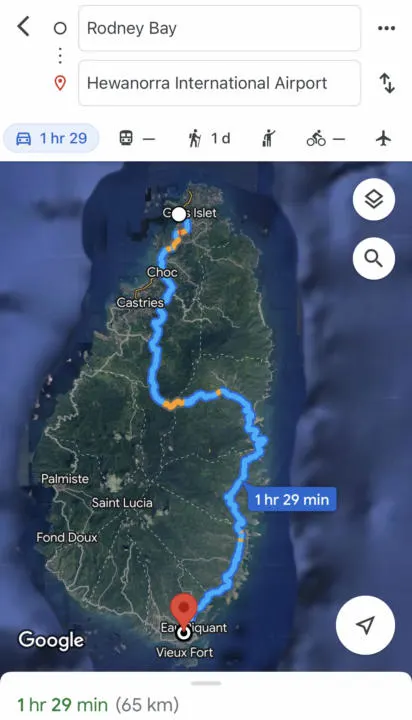
To give you an upper benchmark, a 1.5-hour ride from Hewanorra Intl. Airport to Rodney Bay (nearly the entire length of the island) is about US$75 to $100. Shorter local rides will probably be between $15-$50. They don’t accept credit or debit cards, so plan to carry cash. The local currency, ECD (Eastern Caribbean Dollars) is preferred but they often will accept USD as well.
There are always taxis outside the airports and cruise ship port. If you staying at a hotel or resort, the concierge can certainly help you find a taxi. But it may require some advanced preparation to make sure you have a ride at the time you desire.
Here are a few taxi companies: Saint Lucia Taxi Service, Saint Lucia Airport Transfers, Saint Lucia Executive, Saint Lucia Airport Shuttle, and Real Saint Lucia Tours. But you are sure to find many more once you are on the island.
Rental Cars in St. Lucia
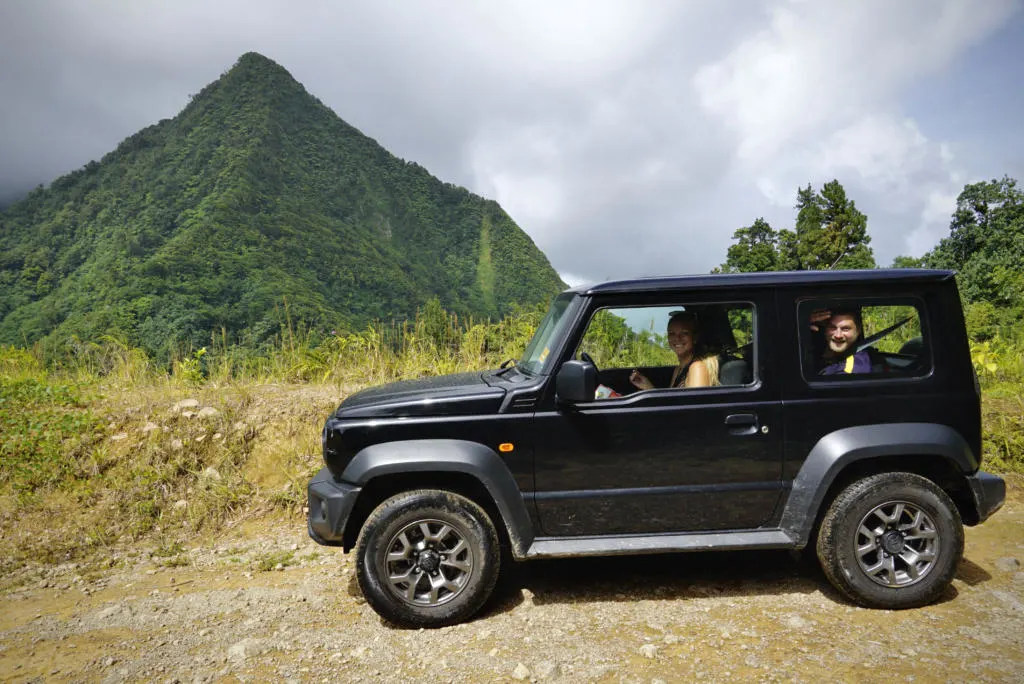
Booking a rental car in St Lucia is another popular way to get around the island. It gives you the most freedom and flexibility out of all the ways to get around St. Lucia. You can simply hop in your car at any time and go.
But the roads in St. Lucia can be challenging and stressful for non-locals. The roads are curvy, narrow, and steep, especially along the west coast and inland. There are also many potholes to avoid, and some destinations require off-road driving. And lastly, in St Lucia you drive on the left side of the road, which is of course opposite of many countries. But luckily all the road signs are in English.
You need to obtain a temporary driver’s permit (US$20 or EC$54). You can get your permit at the airport’s immigration station, a police station, or from your car rental company (probably the easiest method). Be sure to bring a valid driver’s license from your home country.
We paid about US$66 per day to rent a Suzuki Jimny, a small 4-seat SUV with 4×4 and high clearance. That price includes the cost of gas and a driving permit.
Book a rental car and find the best deals!
Buses | Ride On St. Lucia’s Minibus System
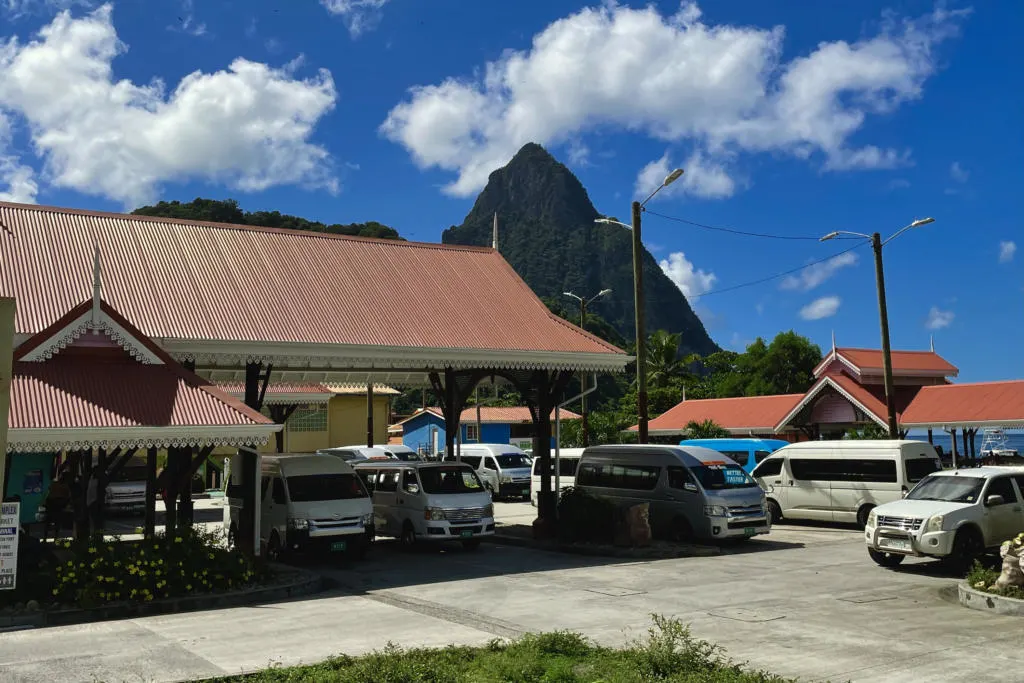
Most of the locals get around St. Lucia with the Minibus system. Thus, it’s the best way to really immerse yourself in the local culture. And it’s also the most affordable way to get around St. Lucia. The main routes are: 1A Castries-Gros Islet, 2H Castries-Vieux Fort, 3D Castries-Soufriere, 4F Vieux Fort-Soufrière. More popular routes have the most frequent service, so it’s quite reliable for getting around the most popular cities, towns, and attractions.
However, it’s not so good for getting to more off-the-beaten-path destinations in St. Lucia. And you also aren’t allowed to bring lots of luggage on buses. So they are better for day trips rather than taking you to and from the airport with all your stuff.
All authorized minibuses have a green license plate with an “M” prefix. The buses are not part of a single state-sponsored enterprise, but rather are owned/operated by individuals or groups who are licensed by the Transportation Ministry. In cities you can catch a bus only from marked bus stations, but in more rural areas you can even flag one down.
Fares range between EC$1.25 to EC$10 (or about US$0.50 to US$3.7). So the minibus system is really quite affordable. But of course, you are beholden to bus schedules for getting around. And they don’t really operate on a set schedule. Once a minibus fills up, they leave, which can occasionally lead to long wait times in less populated areas. The 1A route Castries-Gros Islet offers the longest service, typically from 7am to 10pm. But routes making longer trips (like 3D Soufriere to Castries) may have their last service around 4-5pm. So if you are planning a day trip to another part of the island, start early! And don’t plan to use the buses on Sunday, most are not operating.
I found it really difficult to find precise information about bus “schedules” and routes, which makes it intimidating plan your trip around the buses. But rest assured, the many locals rely on the minibus system for everyday life. You can always use the buses as Plan A, and then pivot to a taxi as Plan B if you happen to find yourself stuck without a bus to take you back.
Water Taxis | For Exploring The Coast
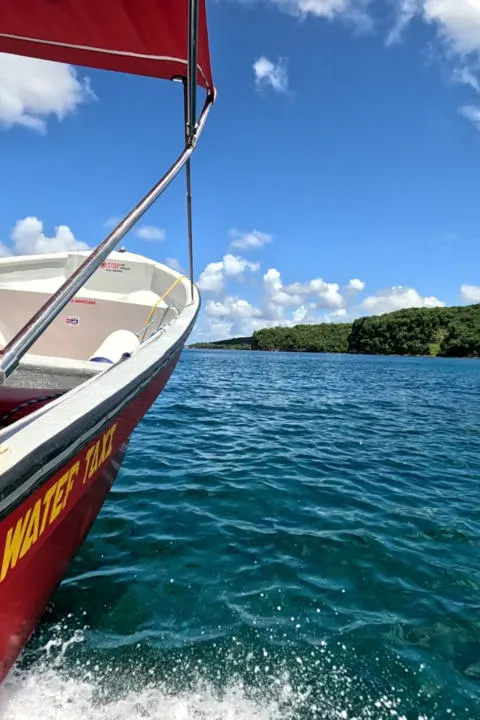
Water Taxis are another popular method for getting around St. Lucia. They probably won’t be anyone’s primary method, but definitely helpful in certain situations. Since the roads are so mountainous in St. Lucia, often times it may be faster to travel by boat to destinations along the coast. We found water taxis to be especially helpful for reaching some of the best beaches in St. Lucia, like Sugar Beach or Anse Chastanet.
And one nice bonus of water taxis is you get to see the island from a different perspective. You are sure to find them for hire around most popular ports, docks, and beaches.
Good Ol’ Fashioned Walking
While we are normally huge fans of getting around on foot, we found St. Lucia to be subpar for walking. There is not very good coverage of sidewalks, and basically non-existent shoulders. But to be fair, St. Lucia uses that space for drainage channels so their roads don’t get washed out any time it rains. So we found ourselves often walking on the narrow roads with cars whizzing by.
We did walk a few places, but we resolved that if we were on the roads anyway, we were safer in our rental car than on foot. So we reserved walking for only very short distances.
And lastly, the hot humid weather is another reason to avoid walking. We would get extremely hot and sweaty within just a few minutes. Unless you are headed to the beach for a dip, you will arrive at your destination likely uncomfortable.
Helicopter Transfers/Tours

Helicopters offer a premium way to get around St. Lucia. Definitely one of the most expensive means of transportation, but way faster than anything else, and also doubles as a unique sightseeing experience. St. Lucia’s legendary Piton mountains, sapphire blue waters, and mountainous rainforests are incredible scenery to see from the sky. Helicopters operate mostly as airport transfers between the north and south of the island. Though some premium resorts like Jade Mountain operate their own private helipad for guests.
St. Lucia Helicopters offers airport transfers as well as scenic tours of the island. The most popular route is the direct airport transfer between UVF and SLU. The transfer takes 10-15 minutes and costs $190 for adults, $171 for kids, and free under 2 years old. This route travels the east side of the island and enjoys “St. Lucias’ lush interior, highest peak (Mt. Gimie), Roseau Dam, the Atlantic Coast, and Marigot Bay.”
Their second most popular route, the West Coast Transfer, takes 5 minutes longer and costs $15 more per person, BUT is designed to showcase the more beautiful west coast of St. Lucia. You get to see the majestic Pitons for which St. Lucia is famous, as well as views of Marigot Bay, West Coast Shoreline (reefs), the rainforest, and the Soufriere Volcano.
Tours And Excursions
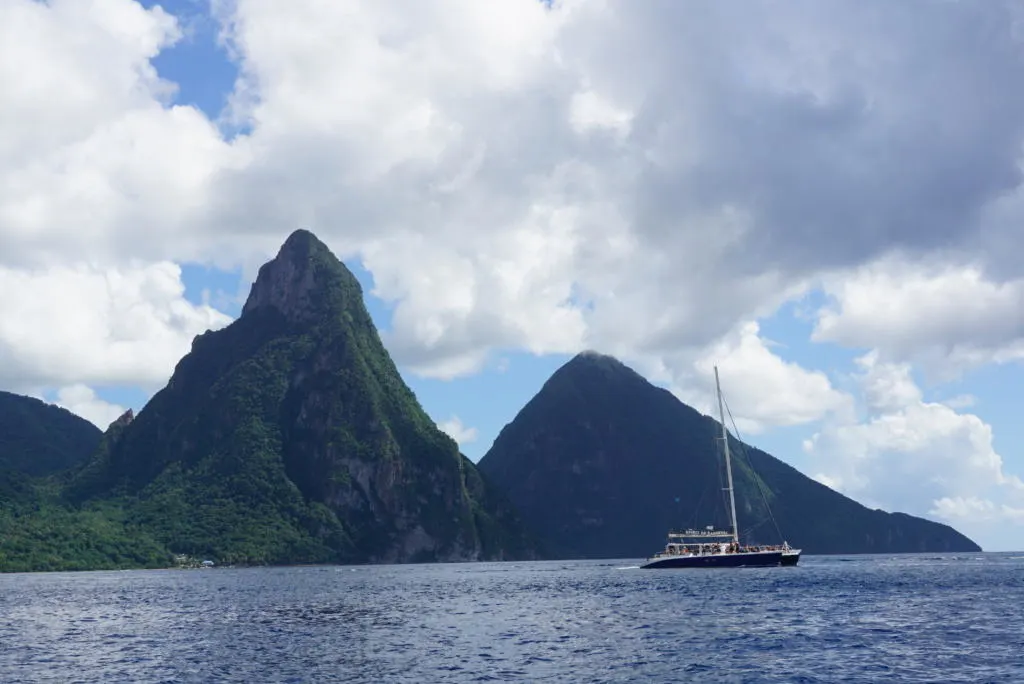
Tourism is huge in St. Lucia, so there are plenty of tour operators on land and sea. If you are interested in exploring some of St. Lucia’s biggest attractions, you can be sure there is a tour operator ready to take you. And many tours include a variety of fun activities in one day. So rather than stressing about arranging separate trips to each destination, tours are a great way to experience many destinations on the island in a single day.
Ferries To Other Islands Near St. Lucia
Ferries are most commonly a form of transportation between islands. They are a great option if you want to visit St. Lucia’s neighboring islands of Martinique, Dominica (Dominique), and Guadaloupe. Prices are around US$120 round trip per person.
Visit L’Express Des Iles or Transport Express Caraibes. These websites are natively in french, so they can be difficult to use unless you use a browser translator like Google Translate on Google Chrome.
What Method Is Best For You To Get Around St. Lucia?
Choosing which method is best for you depends on you what you plan to do in St. Lucia and your budget.
Stationary Resort Type Vacation
I think the most typical vacation to St. Lucia is about a week-long stay at one resort with perhaps a few trips off the resort. Such as a Sandals Resort, who owns 3 different properties in the North. And especially at all-inclusive resorts, guests tend to seldom leave the property. In this scenario, just take a taxi from the airport to your resort (or double-check if they offer a shuttle).
Then, during your stay, use taxis, buses, water taxis, or tours to do your explorations off the resort. Taxis will probably be the most common method, you’ll pay more for the direct and private ride, but most tourists don’t mind spending up to save time and hassle on their vacation. Buses will be the most affordable if your resort/accommodation is close to a route.
Exploring/Adventurous Type Vacation
But another type of vacation to St. Lucia might involve a lot more exploration of the island. For example staying at a hotel or Vacation Home Rental, where visitors often leave their accommodation to visit restaurants, markets, beaches, and other attractions. Or perhaps you are adventurous like us, and want to go hiking, see waterfalls, hot springs, rainforests, and more.
For this type of trip, I would consider renting a car for your stay. Especially if you plan to use the car most days. A rental car gives you the most freedom to just make spontaneous plans. However, only rent a car if you are comfortable driving on the left, managing the mountainous roads, being your own navigator, and staying sober.
Otherwise, you can still explore St. Lucia just fine with taxis, minibusses, water taxis, and tours. If you can navigate the bus system, that will be the most affordable option. Otherwise, the taxis, water taxis, and tours will cost more, but offer a more private, direct, and tourist-oriented service.
Compared to a rental car, these options will require a little more advanced planning to book rides, find drivers, etc. But this way you can remove the stress of driving yourself, let locals do all the navigating, and even enjoy some alcohol if you like.

When comparing price, it kind of depends on how many different places you visit in a day. As noted, the minibus system is by far the cheapest. So the more debatable price comparison is between renting a car or taking taxis everywhere.
We spent US$66 per day on a rental car. But there were some days the car sat idle because we had booked other tours or watertaxis to get around that day. Taxi rides are typically anywhere from US$20-80 for an average ride. If you are taking 2-3 taxi rides per day, it will likely be more expensive than renting a car. But many tours will take you to many popular destinations in a single day which will provide savings versus booking taxi rides to each place individually.
If you are on a really tight budget, utilizing the minibus system is a good way to save a ton of money. But be prepared to be more flexible with timing. And also lose some time on your trip waiting for buses, and walking to bus stops. It is the best way to experience St. Lucia like a local, rather than a tourist. But in our experience, if you have white skin, nobody is going to confuse you for a local. Luckily, the St. Lucian people are generally very welcoming and cheerful.
If you have the financial means, a helicopter transfer along the west coast would be a really cool way to start or end your trip.
I hope this guide is helpful for deciding how to get around St. Lucia!
Save This Post For Later
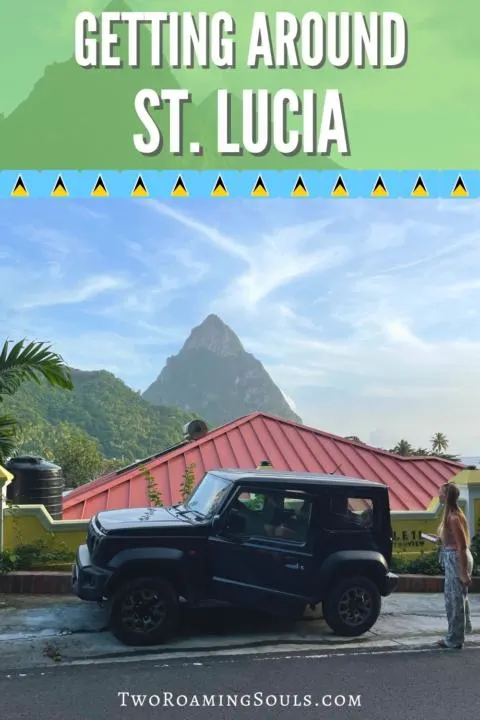


How To Get To St. Lucia (Plane, Cruise, Charter?) - tworoamingsouls
Thursday 6th of April 2023
[…] that you have made it to Saint Lucia, how do you even get around the island? These modes of transportation in St. Lucia are the best ways to get […]
Where To Stay in St. Lucia Ultimate Guide (Which Side Of The Island Is Best)? - tworoamingsouls
Friday 17th of March 2023
[…] getting around the island of St. Lucia, most people just take a taxi or shuttle to their hotel or resort. And then maybe book a tour or […]
Best Beaches in Soufriere | Ultimate Guide - tworoamingsouls
Tuesday 13th of December 2022
[…] Driving: The most budget-friendly option is to drive to the beach if you are renting a car. But the resort doesn’t always allow you to drive directly down to the […]
Best Things To Do in Soufriere, St. Lucia | The Complete Guide - tworoamingsouls
Tuesday 29th of November 2022
[…] If you are stuck planning how to get around, check out our other guide for different modes of transportation in St. Lucia. […]
How To Plan A Trip To Saint Lucia - tworoamingsouls
Friday 25th of November 2022
[…] That shouldn’t totally steer you away from renting a car, because it definitely allowed us the ultimate freedom to do what we wanted and not be on a tight schedule. Check out our review of renting a car on the island of St. Lucia. […]